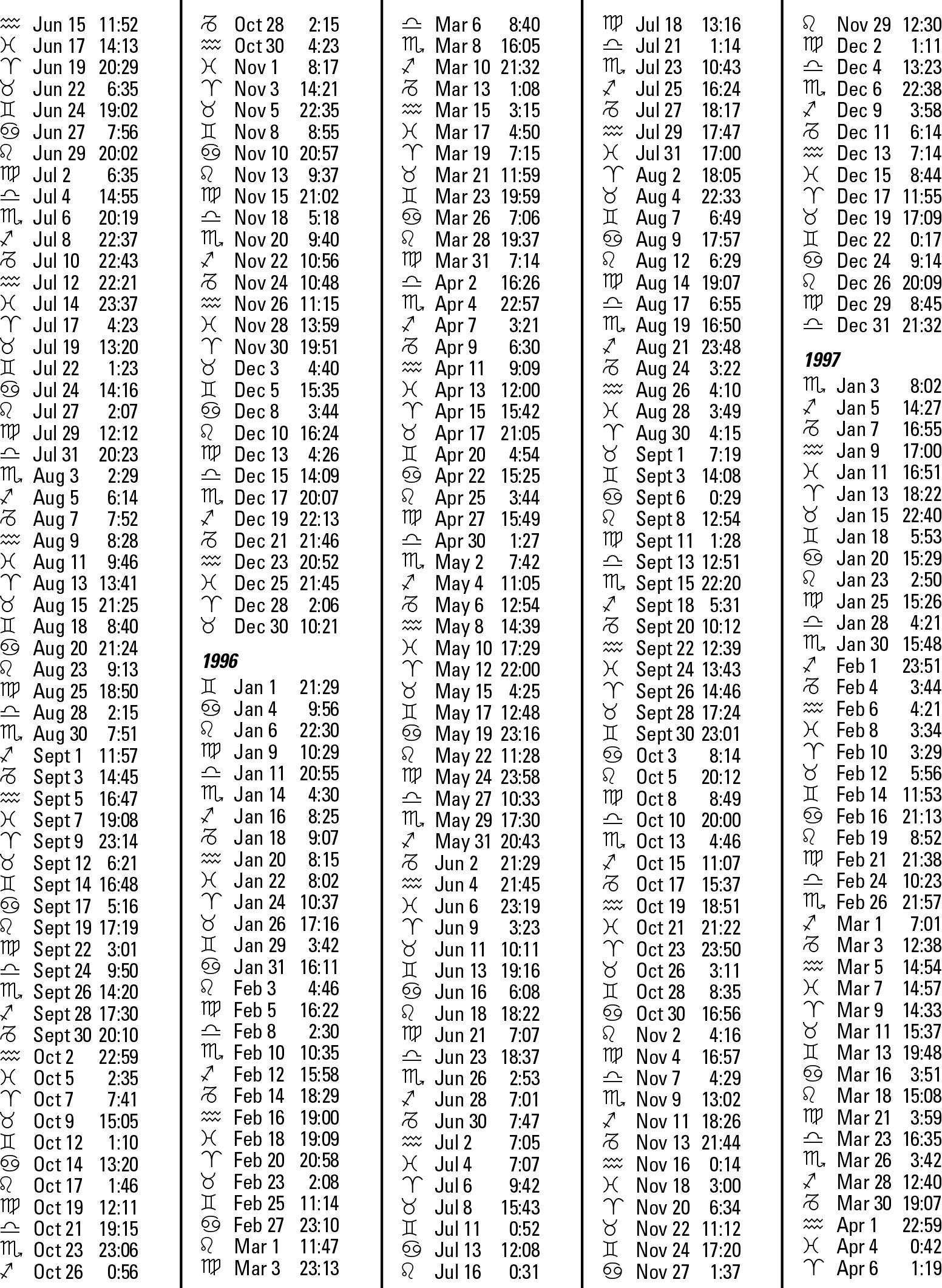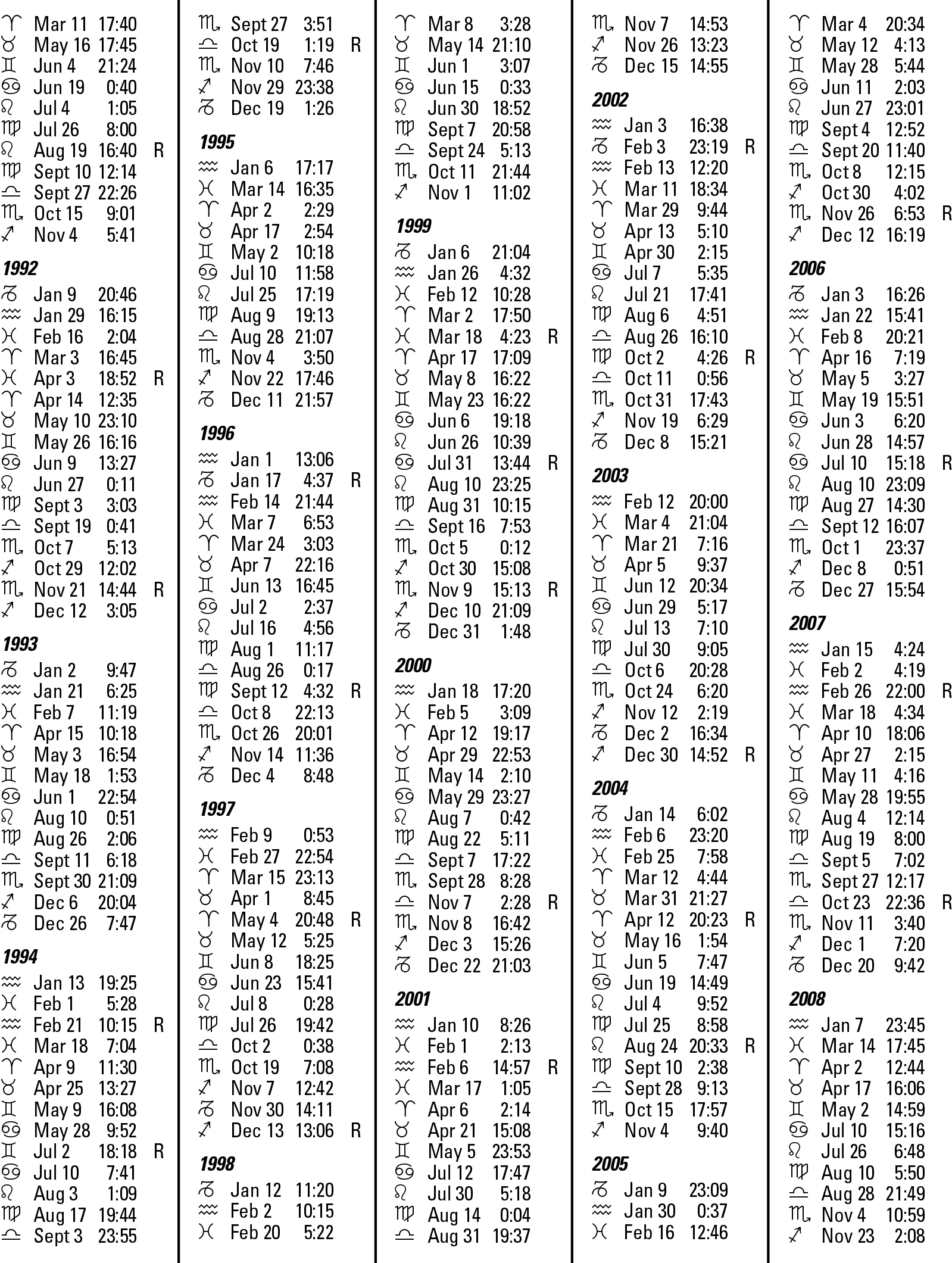Appendix
Planetary Tables
T his appendix gives the location, by sign, of the Sun, the Moon, the planets, the Nodes of the Moon, and the asteroid Chiron between 1930 and 2012.
The tables list the day and time for every entrance (or ingress) into a new sign for each of these celestial bodies. The tables are in the following order:
 Table A-1: The Sun
Table A-1: The Sun
 Table A-2: The Moon
Table A-2: The Moon
 Table A-3: The Nodes of the Moon
Table A-3: The Nodes of the Moon
 Table A-4: Mercury
Table A-4: Mercury
 Table A-5: Venus
Table A-5: Venus
 Table A-6: Mars
Table A-6: Mars
 Table A-7: Jupiter
Table A-7: Jupiter
 Table A-8: Saturn
Table A-8: Saturn
 Table A-9: Uranus
Table A-9: Uranus
 Table A-10: Neptune
Table A-10: Neptune
 Table A-11: Pluto
Table A-11: Pluto
 Table A-12: Chiron
Table A-12: Chiron
The first column in each table tells you the sign the planet is entering. (The Cheat Sheet at the beginning of this book lists the symbol for each sign.) The second column gives the date when the planet moves into that sign. The third column shows the time when the shift takes place. Time is written in military style, so 0:18 means 18 minutes after midnight, 16:09 is 4:09 in the afternoon, and 23:57 is 11:57 at night. In some cases, the letter “R” follows the time. This R stands for retrograde. It tells you that on that particular day, the planet was retrograde. It doesn’t tell you when the planet went retrograde or when it ceased to be retrograde and went direct. (See Chapter 18 for the retrograde dates of Mercury, Venus, and Mars for the years 2007 to 2012.)
The tables in this appendix use eastern standard time. If you weren’t born in eastern standard time, you have to make adjustments. Let’s say you were born in Chicago. Since Illinois observes central standard time, Chicago is one hour behind the East Coast — that is, it’s one hour earlier there. To account for that difference, you have to subtract one hour from the times listed in the tables.
For example, Pluto swung into Sagittarius on January 17, 1995, at 4:16 in the morning, EST. In Chicago, that momentous event occurred one hour earlier, at 3:16 a.m. In Denver, it was 2:16. In Los Angeles, it was 1:16. And so on.
The following is a partial list of the adjustments you have to make, depending on where you were born:
| If You Were Born In | Do This |
|---|---|
| Central standard time | Subtract 1 hour |
| Mountain standard time | Subtract 2 hours |
| Pacific standard time | Subtract 3 hours |
| Alaska standard time | Subtract 4 hours |
| Hawaii standard time | Subtract 5 hours |
| Most of Brazil and Argentina | Add 2 hours |
| British Isles and western Africa | Add 5 hours |
| Western Europe | Add 6 hours |
| Middle East, Norway, and South Africa | Add 7 hours |
| India | Add 101/2 hours |
| China | Add 13 hours |
| Australia | Add 12–15 hours |
And don’t forget about daylight saving time. If it was in operation at the time of your birth, or if you’re looking up the current position of the planets during daylight saving time, you must subtract an additional hour. For many years, daylight saving time began at 2 a.m. on the first Sunday in April and ended at 2 a.m. on the last Sunday in October. That has changed. As of 2007, DST extends from the second Sunday in March to the first Sunday in November.
Note, too, that the tables in this appendix cover the years from 1930 to 2012 — even when it doesn’t look that way. The Pluto Table (A-11) begins in 1937 with the entrance of Pluto into Leo on October 7. Before that, Pluto was in the previous sign — Cancer. Similarly, the last entries for Pluto are in 2008. On January 25 it enters Capricorn. On June 14 it slips back into Sagittarius. (Notice the R next to that entry, indicating that it’s retrograde on that day.) Finally, on November 26 it reenters Capricorn, where it remains until well past 2012. No further entries are required.





































































